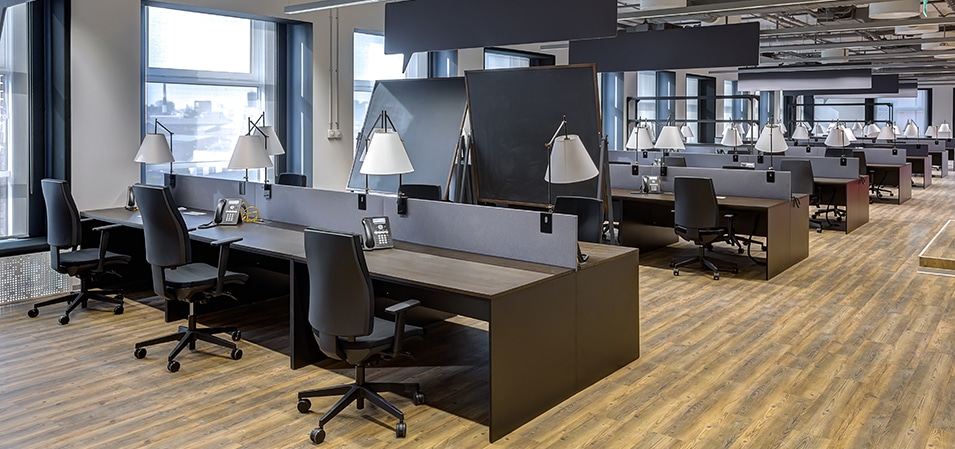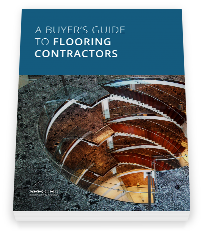A comprehensive guide to commercial office flooring buying considerations

Flooring products are not one-size-fits-all. When selecting products for an office building, you need to weigh a wide range of factors —design considerations, installation time, price point and more— to land on the materials best-suited to your building’s particular needs.
In most applications, life cycle costing (LCC) is the best way to decide which flooring product to go with. Not so in office applications. Longevity —though important— is not the main concern for commercial office buildings. Instead, design considerations and architectural detail tend to lead the charge in product selection.
The reason is this: facility managers want to maintain a Class A office quality rating for their buildings. Office buildings are unofficially categorized into three classes (A, B and C) which can be used justify differences in rent. Generally speaking, Class A buildings are newly constructed or renovated buildings with high-quality finishes — and can, therefore, command higher rent prices. Class C buildings often haven’t been touched in 20 years or more, and are the least desirable office buildings.
While some flooring systems can last 20 years or more, you’re likely going to renovate your building and replace your flooring long before it wears out in order to maintain your position as a Class A office building.
That’s why, in office flooring applications, function follows form. While durability is important, it shouldn’t be your guiding principle. Instead, ask yourself these two questions before deciding on flooring products for your commercial office.
2 questions you need to ask yourself before purchasing a flooring product
1. What do you expect out of this flooring system?
This is the first question you should ask yourself. Above all else, you need a flooring system that will serve the needs of your application for the duration you will be using it.
-
Application
Think about what you need out of your flooring system. If lots of high-profile clients come in on a daily basis, it might be worth investing in an upscale flooring system that will impress. If not, then perhaps you should choose the cheapest alternative that serves your traffic needs.
-
Duration
If you own the building in question and don’t plan to renovate again for at least 10 years, then durability should be a consideration. While your flooring material likely won’t need to last 20 years, it will need to serve its purpose and maintain its appearance for the entirety of the time you’re using it.
If, however, you’re a tenant and plan on leaving in a few years, then there’s no practical reason to choose a top-of-the-line flooring material. Pick something that will cost-effectively serve your needs in the interim before you move onto another building.
2. How much downtime can you manage for installation?
Speed of installation is another key consideration, especially when downtime isn’t an option. Depending on the amount of time you allot for installation, some products might work better than others.
Let’s look at an example. A facility manager recently came to us wanting to redo a 10,000-square-foot office space with porcelain tile. They could only close between 3:30 p.m. on Wednesday and 7 a.m. on Monday. And the office building had to open on Monday.
Porcelain tile worked for the application and fit comfortably into their budget. From a practical standpoint, however, the installation would exceed their allowed downtime. Wanting to meet the client’s scheduling needs, we looked into material alternatives.
We ended up recommending a material that provided the same aesthetic look and functionality, but would fit into their installation window: luxury vinyl tile (LVT) made to mimic the look of porcelain. And beyond the cost- and time-savings, LVT was cheaper and easier to maintain. They chose the material and, in the end, their building opened Monday at 7 a.m. sharp — right on schedule.
Typically, if one product doesn’t fit into your budget or installation window, there is another perfect-fit product your flooring contractor can recommend in its stead.
Since the answers to these questions vary widely case by case, it’s important to talk through your options with an unbiased flooring contractor. Unlike a manufacturer, who is likely to plug their products, a contractor will first look to understand your needs — and then recommend the best-fit products for your building. To find out what you should look for when partnering with a flooring contractor —and to learn the benefits you should demand from the partnership — read this buyer’s guide to flooring contractors.

A buyer’s guide to contract flooring
How to get the greatest value for your floor and select the right contractor for your project.
Common commercial office flooring products: Pros and cons
There’s a wide range of materials that will serve the needs of an office application. Choosing between them, therefore, becomes a matter of design, budget and personal preferences. Still, there are some tried-and-true materials you should consider: luxury vinyl tile (LVT), quarry tiles, terrazzo and carpet tiles.
For more guidance on which product to implement in each distinct area of your office, read our room-by-room guide to office flooring materials.
Luxury vinyl tile (LVT)
LVT is one of the most versatile office flooring materials out there — there really isn’t an area in your office you can’t put LVT. There are LVT products made to imitate almost every premium flooring material, such as porcelain tile, hardwood, marble and other materials. Available in planks, hexagonal tiles and sheets, you can incorporate LVT into almost any design scheme. It’s quick to install, easy to maintain and visually appealing — everything you need out of an office flooring product.
As with everything, though, you get what you pay for. There’s a wide range of products at every price range, from standard sheet LVT to luxurious marble finishes. With so much variation in LVT, it’s not really a question of whether or not you should use it, but which product and where. Your contractor can guide you through your options and help you select the best-fit product for your price point and design needs.
Terrazzo
Terrazzo is a highly durable product, and will sustain its lustrous appearance for decades if regularly cleaned and maintained. It’s just about as close to a forever decision you can get in commercial flooring.
And as far as design considerations, you’d be hard-pressed to find a product more versatile. There’s virtually limitless color and shape options, making it perfect for greeting visitors with a custom design or logo in your entranceway. Designers incorporate terrazzo when they want to impress. Think showrooms, high-end reception areas and architects designing their own offices.
Of course, terrazzo is at the upper end of the price spectrum, making it cost-prohibitive for many office applications. But for high-end office applications, it’s a long-lasting and attractive option worth considering.
Carpet tiles
Carpet tiles are your best soft-surface flooring option for office applications. They’re versatile in application, and can be incorporated just about everywhere in your office except the bathroom. While tiles are more expensive than broadloom carpets, they are better equipped to handle heavy traffic loads and are more easily maintained throughout their usable life.
Most carpet tiles —even at the lower end of the price spectrum— are suitable for the traffic needs of an office. Generally speaking, as the price of a carpet tile goes up, you’re paying for complexity design rather than durability.
In terms of functionality, tiles are much easier to maintain than broadloom rolls — it’s much more time- and cost-effective to replace a small tile than an entire 12-foot roll of carpet. And in an open office area with cubicles, the modular nature of a carpet tile system is especially helpful. Rather than having to move all the cubicles along a roll of carpet when replacing it, you can simply replace the tile in question and move on.
Quarry tiles
Quarry tile is a cost-effective flooring option for back-of-house spaces such as receiving areas, corporate kitchens or spaces where function trumps form.
Quarry tile is a no-frills product. Provided it’s been installed and maintained correctly, a quarry tile floor will last as long, if not longer, than you need. Make sure you use the right installation materials –epoxy grout and thin-set adhesives— and that the surface has been tested for moisture prior to installation. As to maintenance, just sweep and mop regularly and replace sections as they wear out.
Although quarry tile isn’t the most aesthetically versatile product, we have seen some designers incorporate it in foyers and outdoor entrance areas because it’s an exceptionally long-lasting product. If you’d like to use quarry tile in an upscale office application, you’ll just need to be more creative to achieve your design vision by mixing colors and angles.
With more than 350,000 flooring projects under our belt, we’ve learned quite a bit about which products work best in office applications, and we’ve compiled it into a free, easy-to-read product guide. To learn more about other materials —and other important considerations when selecting commercial flooring products— be sure to check out our beginner’s guide to flooring products.
The beginner’s guide to flooring products
At Spectra Contract Flooring, we’ve completed more than 350,000 flooring installations nationwide using every material on the market. We’ve created this introductory guide as a resource for those new to commercial flooring, giving you a rundown of flooring materials. It will cover several factors crucial to the success of your project.
